Menu
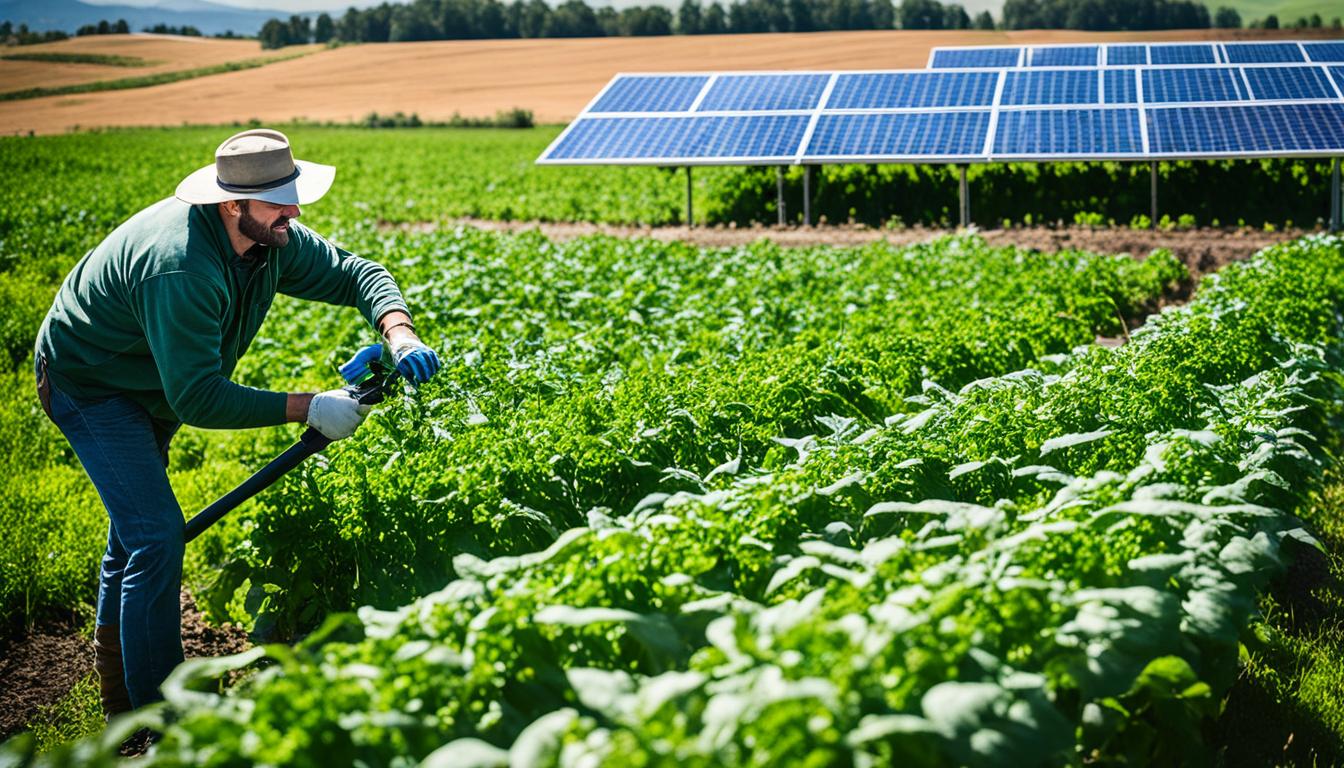
Did you know that out of over 200,000 plant types we could eat, less than 20 provide most of our food? This eye-opening fact shows why we need to focus on sustainable farming. As people care more about how their choices affect the planet, green farming methods are getting more popular. This article will show you some cool ways farmers are helping the earth while growing food.
Using new technologies that help the earth and make farming better is crucial. We’ll look at precision agriculture, green tech, and ways to use less waste. These methods are making our food systems more eco-friendly and sustainable. Let’s dive into the details of these exciting changes in the farming world.
Sustainable farming is now essential, not just a passing fad. With our population growing and resources shrinking, it’s a must. These environment-friendly farming solutions are vital. They affect our future in big ways.
Crop rotation and diversity make the soil 30% healthier. They cut pest control bills by 20%. And they boost crop output by 25%. Adding cover crops and perennials cuts soil erosion by 40%. They improve soil’s nutrient holding by 15%. Plus, they lessen chemical fertilisers by 20%.
Using reduced tillage methods slashes soil erosion by half. It ramps up soil health indicators by 35%. Turning to integrated pest management (IPM) lowers chemical pesticide use by 25%. This keeps pest control above 80%.
Mixing livestock with crops increases farm profits by 10%. It drops waste costs by 15%. Crop outputs rise by 5% as soil gets better. Agroforestry practices mean 30% more biodiversity. They boost water retention by 20% and farm revenues by 10% with extra fruit or nut crops.
| Practices | Benefits |
|---|---|
| Crop Rotation and Diversity | 30% improved soil health, 20% reduced pest control costs, 25% enhanced crop yields |
| Cover Crops and Perennials | 40% reduced soil erosion, 15% increased nutrient retention, 20% decreased fertiliser usage |
| Reduced Tillage Methods | 50% decreased soil erosion, 35% improvement in soil health indicators |
| Integrated Pest Management (IPM) | 25% reduction in pesticide use, over 80% pest control efficacy |
| Livestock-Crop Integration | 10% higher farm profitability, 15% reduced waste management, 5% increased crop yields |
| Agroforestry Practices | 30% higher biodiversity, 20% better water retention, 10% more farm revenue |
Whole system management can cut nutrient runoff by 40%. It boosts pollinators by 25% and farm productiveness by 10%. Good soil practices lead to a 15% rise in farmer earnings. They also make communities better off through food security.
Adding diversity and complexity to farming brings big benefits. It cuts climate risks by 20%. It makes ecosystems 30% tougher. And it boosts farm staying power by 25%. These steps towards eco-friendly farming make a difference now and for the future.
Precision agriculture is changing how farmers work. It now uses high-tech tools to make farming better for everyone. Things like advanced mapping and soil sensors help save money and the planet. By using just what’s needed, farmers grow more crops and spend less.
High-tech maps are a key part of precision farming. They use satellites and drones to check on crops up close. This helps farmers divide their fields into sections so they can look after them better. Drones with special GPS technology can even place seeds and fertiliser exactly where they’re needed. They’re so accurate that they save time and help farming be more productive.
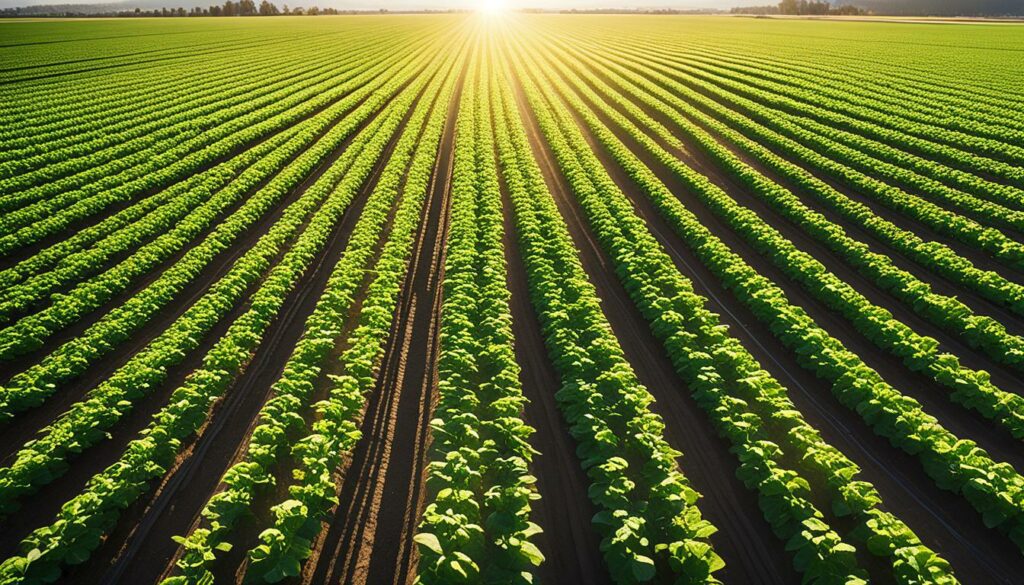
Soil sensors are game-changers in farming. They give farmers instant updates on how their soil is doing. This means they can water and feed their plants smarter. By looking closely at soil, farmers can give just the right amount of fertiliser. They don’t have to use as much, and they use fewer chemicals too.
Using resources better is key in precision farming. This new way of farming has meant bigger harvests and less waste. It has also cut down on using gas and water. With tools like Variable Rate Technology, farmers don’t waste anything. They can make sure they only give their crops what they really need.
In recent years, farm automation technologies have changed farming. They offer better efficiency and need less human work. This is important as the world’s population grows and we aim for more sustainable farming.
The rise of self-driven tractors is a big deal. Companies like John Deere lead the way. These tractors are very accurate and save a lot of energy. That means less chance for mistakes and lower farm costs.
Autonomous weed detection is a game-changer too. It uses smart sensors and AI to find and get rid of weeds. This cuts down on the need for harsh chemicals and tedious weeding work. It’s good for saving resources and protecting the environment.
Laser scarecrows keep birds away and protect crops from big pests. They use laser beams to scare birds but not hurt them. This keeps the harvest safe and lowers crop damage. It’s a high-tech twist on an old method that works well.
Technologies like self-driven tractors, weed detection, and laser scarecrows are changing farming for the better. They boost how much we can grow and help the environment. It’s good news for farmers, lowering their costs, and making farming greener.
Indoor vertical farming is tackling limited space and tough weather. It uses special farming techniques for growing crops in cities. This method is a game-changer, cutting down on water and pesticides. It’s key for the future of farming.
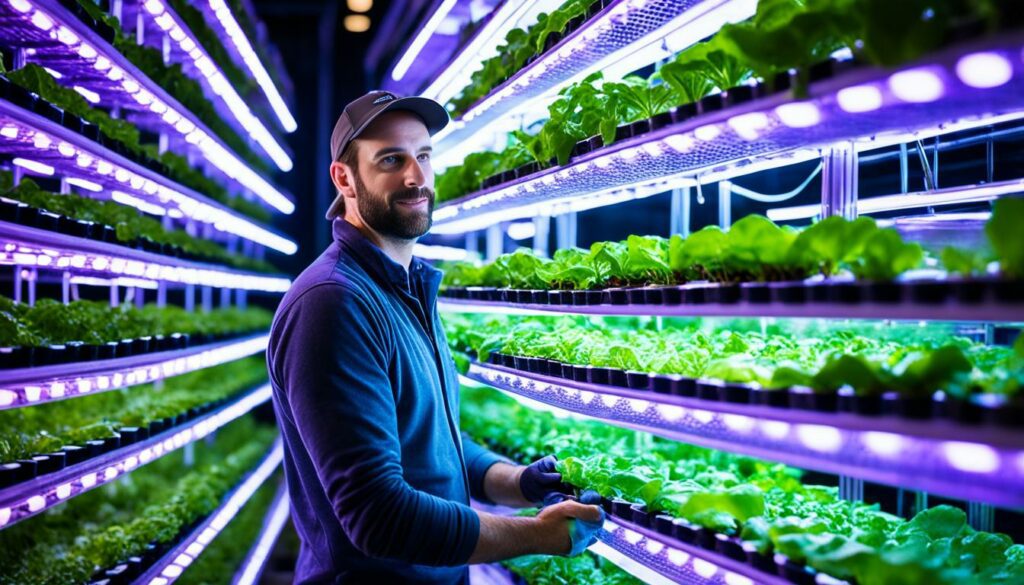
Hydroponics grows plants in water, not soil. It cuts down soil erosion and the need for pesticides. This way of farming uses less water and fertiliser than usual. In fact, one square metre indoors can produce as much as 50 square metres outdoors, says the Vertical Farming Institute.
Aeroponics is another cool method, growing plants in the air. They get sprayed with nutrients. This uses much less water than hydroponics. AeroFarms has grown over 550 plant types, showing aeroponics is a bright option for the future.
Indoor farming needs careful control of its environment. This means setting the right temperature, humidity, and light levels. It helps plants grow all year despite outside weather. By using renewable energy and smart farming setups, these farms are very efficient. They use up to 95% less water than regular farms.
The use of indoor farming methods helps save our environment. It’s great for cities where space is tight. Plus, it’s a big step towards making farming more eco-friendly.
| Method | Water Usage Reduction | Key Benefits |
|---|---|---|
| Hydroponics | 95% | Reduces soil erosion, minimises pesticide use |
| Aeroponics | 90%+ less than hydroponics | Maximises nutrient delivery, more sustainable |
Bee vectoring technology is changing farming for the better. It uses bees to help plants grow by pollinating them and spreading good microorganisms. This way, farms can produce more without harmful chemicals, making farming better for the planet.
The success of bee vectoring technology is clear from tests and real farm results. For example, a farm in Georgia saw their blueberry yield go up by 28%. In Florida, using a specific type of bee vectoring product led to a 35% drop in a common plant disease in their strawberry fields.
This technology boosts how well plants get pollinated. It helped raise the average pollination success from 50% to 65-68%. Plants like almonds, berries, and sunflowers saw big improvements in growth and health.
| Statistics | Impact |
|---|---|
| Yield increase at Major League Blueberries | Up to 28% |
| Reduction in Botrytis incidence | 35% |
| Pollination success rate | Increased to 65-68% |
| Return on investment | 20x the cost |
The Environmental Protection Agency (EPA) approved the BVT system in August 2019. They found it’s safe for bees and doesn’t overuse water or pesticides. This helps both the environment and farms.
More tests are being done in states like Michigan and California. With food demand climbing, bee vectoring is a key part of farming’s future. It’s not just for certain plants – soon, it will help grow more types of food sustainably.
Agriculture uses a lot of water, about 80% of the water in countries. Yet, only a tiny bit of the world’s water is suitable for drinking. So, finding new ways to treat water in farming is really important.
Using high-tech methods to recycle water can help farms use less fresh water. This lowers the pressure on our limited drinking water supplies and helps the environment.
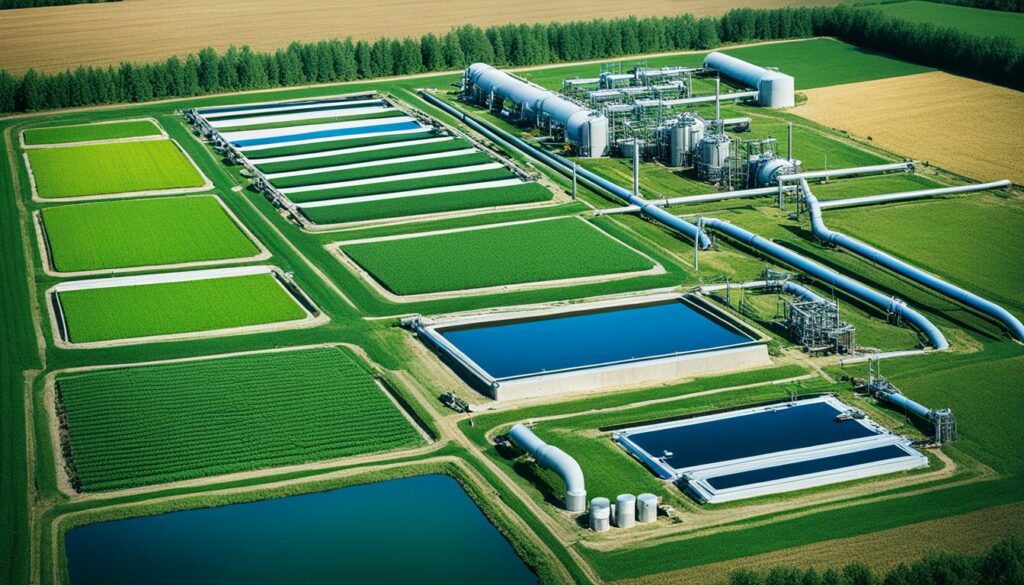
The U.S. Department of Agriculture (USDA) has set big goals for farming by 2050. They hope to increase food growth by 40% and cut down harm to the environment by a half. Achieving this depends a lot on new ways of treating and reusing water in farms.
Closed-loop systems are great for saving water. They treat and use water again at the same place, which means farms need to use less new water. After treating, wastewater from towns can safely water crops, making farming more efficient and eco-friendly.
This method is very effective at removing about 95% of medicine in the water. So, the water used on crops has extremely low levels of medicine, which is great for the environment.
Using water again in farming is crucial for a sustainable future. There are many ways to clean water so it can be used again on farms safely. The cleaning is so good that the amount of medicine in the water is very, very low.
Research shows that the medicine levels are as low as finding only a few people in the entire world! This shows how safe and useful these water recycling methods are when they are well looked after. Learn more about USDA’s views on using treated wastewater for watering fields.
Waste water treatment in farming is not just a must-do; it’s a key part of caring for our water and planet. By using closed-loop systems and good water recycling, the farming sector can move towards a future that is stronger and better for the planet.
| Statistic | Details |
|---|---|
| Drinkable Water | Approximately one-half of 1% of the planet’s water is drinkable |
| Agricultural Water Consumption | Over 80% of the nation’s water consumption |
| USDA Production Goal | Increase U.S. agriculture production by 40% while cutting the environmental impact by half by 2050 |
| Pharmaceutical Concentration | Up to 95% removed by urine, resulting in very low ppb concentrations in treated wastewater |
| Comparative Safety | Equivalent to finding eight people in the global population per ppb in wastewater |
Drone tech and AI are changing farming for the better. They help farmers watch their crops closely and manage their land well. At big shows like the Farm Bureau’s convention and the Commodity Classic in Houston, drones and robots were the stars.
New AI-powered software is making crop monitoring live and direct. Before, farmers waited for soil data for weeks. Now, they get it right away, thanks to drones. This quick access to accurate data means farmers can act fast to make their farms run better.
AI is driving these changes. It’s making sure that always keeping an eye on crops becomes a key part of farming today.
Drones can find pests and diseases with the help of smart sensors and AI. This means less need for harmful chemicals. It also helps farmers grow healthy crops more efficiently. So, with the help of drones, farming is getting smarter and more sustainable.
Using drones gives farmers information to make smart choices. AI helps by offering insights and managing tasks like planting. This makes sure that farms use resources well and reduce waste.
But, it’s important to use these new technologies wisely and fairly. Creating good rules about how AI is used makes farmers trust these tools more.
| Aspect | Value |
|---|---|
| AI Engineers Cost | Hundreds of thousands annually |
| Cost of Mid-sized AI | $100,000 to $9,000,000 |
| Cost of AI Drone | $150,000 |
| ROI per Acre (Drones) | $2-$12 |
| Adoption Rate | Less than 10% |
The future of agriculture includes more AI-powered drones. As small and medium farms see how helpful and efficient these tools are, they are likely to use them more. This shows that precision crop watching is key for the future of farming.
Sustainable crop production is key for environment-friendly farming. By using renewable resources in agriculture, farmers boost their output. They also help protect the land.
Using different farming methods can improve the soil. This includes planting crops together and changing them each year. It helps the soil stay healthy and fights off insects. This makes sustainable crop production better by lowering the risk of pests and keeping the soil good.
Adding cover crops and plants that live for many years helps health too. These plants can mean less need for harmful chemicals. Farmers also till the land less rough, so the soil doesn’t wash away easily.

One big step in sustainable crop production is cutting back on using pesticides. Integrated Pest Management (IPM) does this well. It’s about controlling pests without using a lot of chemicals.
Having both animals and crops work together is also important. This way of farming makes a better balance. It helps more living things thrive and makes farms do better.
| Method | Benefit | Example |
|---|---|---|
| Crop Diversity Practices | Improves soil health and pest control | Intercropping |
| Cover Crops | Reduces need for fertilisers and herbicides | Planting perennials |
| No-Till Farming | Decreases erosion, enhances soil quality | Reduced-till methods |
| Integrated Pest Management | Minimises pesticide use | Systematic pest control |
| Livestock Integration | Increases farm efficiency and profitability | Mixed farming systems |
Also, planting trees and bushes in farming areas can be good. It not only brings in extra money but keeps the land safe. Looking after the whole area is key. It stops the land from washing away, keeps water clean, and lets wildlife thrive. This all fits into the bigger aim of using renewable resources in agriculture.
Keeping the soil in good shape is very important. This is even more crucial as the world gets more crowded. We need to grow a lot more food in the future.
In the end, sustainable farming is crucial. It creates a strong food system for all. It’s the best path for the future of farming.
To tackle issues like soil health decline and climate change, embracing regenerative farming is key. This approach involves methods like cover cropping and minimal tillage. They help boost soil health, increase plant and animal diversity, and support a healthier farming system.
Cover cropping means planting certain crops to protect the soil. This cover reduces the need for artificial fertilisers, prevents soil erosion, and improves water storage. It also boosts the soil’s natural fertility. As a result, farmers can use fewer chemicals, making the farming process more eco-friendly.
Minimal tillage is a way to lessen soil disturbance. It involves ploughing less frequently and deeply. This helps keep the soil healthy by maintaining its structure, preserving moisture, and supporting more life underground. It’s especially useful for preventing soil erosion and keeping valuable nutrients in the soil. And, it saves farmers money by reducing how much they spend on fuel and machinery.
Improving soil health is at the heart of regenerative farming. Stronger, healthier soil helps plants grow better and the entire ecosystem to thrive. Farmers do this by using natural fertilisers, changing the types of crops they grow, and mixing in some animals. These steps increase the living matter in the ground, making sure that plants get all the nutrients they need.
The world is showing a big interest in regenerative farming, with billions invested in the last five years. There are 159 companies exploring these sustainable methods. The main reasons behind this trend are the benefits for the environment and the promising economic outcomes.
| Indicators | Statistics |
|---|---|
| Investment in Last 5 Years | $2.61B |
| Number of Companies | 159 |
| Increase in Market Deals | 2.31% |
Learning and applying regenerative farming techniques is vital for sustainable agriculture. It’s all about cover cropping, minimal tilling, and enhancing the soil. This way, we can ensure the health of our farms and the planet’s wellbeing for our children and grandchildren.
Today, green technology is changing the face of agriculture. It’s part of a revolution towards sustainability. This is vital due to our world’s increasing population and worries about the environment.
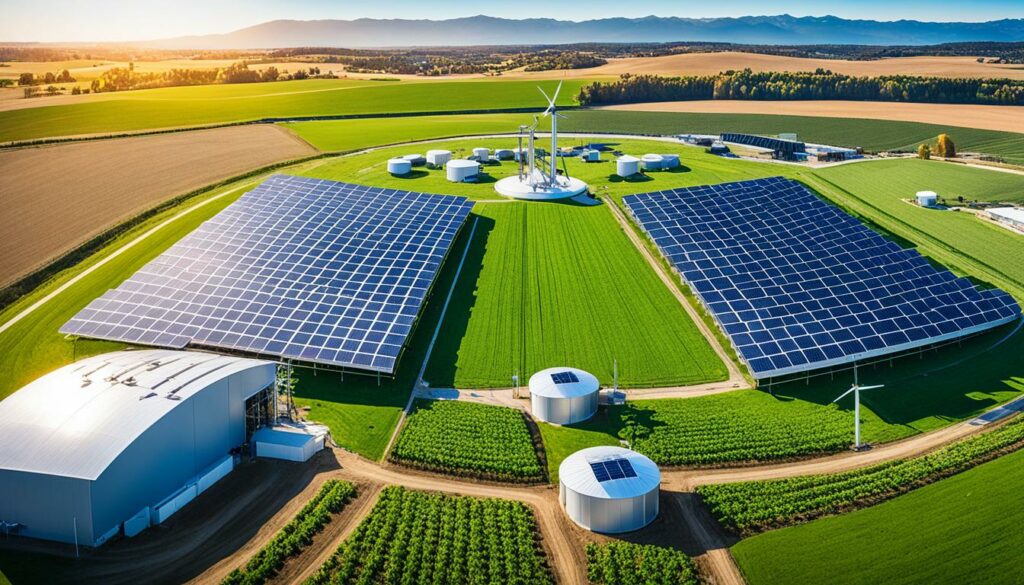
One key innovation is the electric tractor. It runs with zero tailpipe emissions, helping the environment. These tractors use global positioning systems and telemetry devices to find the best routes. This saves energy and uses less fuel.
Now, onto saving water. Rainwater harvesting systems collect stormwater. This means farms don’t need as much fresh water. And since less than 0.5% of Earth’s water is fresh and accessible, every drop saved is crucial.
Biotechnology is another major player. It creates plants that fight off bugs and disease. This reduces the need for pesticides and cuts down food waste by 30%. The waste happens during the production and picking stages.
Green technology also includes smart sprinklers. They check if the ground is already wet before watering. This stops the soil from getting too much or too little water. By doing this, farms use water in a smart way.
LED lights are changing how we farm, too. They use 75% less electricity than old bulbs. And they last 25 times longer. Vertical farms use these lights to grow food in cities. They use 70-95% less water and can harvest all year.
Drones are becoming common in farming. They watch crops closely and in real time. This lowers crop waste and makes farming greener. With drones, farmers can make choices based on powerful information. This can lead to bigger harvests and smarter work.
In the end, green technology is the future of farming. It helps farmers do better while caring for the planet. It’s about growing food in ways that last, so future generations can also enjoy it.
| Technology | Benefits |
|---|---|
| Electric Tractors | Zero emissions, promote clean agriculture |
| Rainwater Harvesting | Conserves freshwater, reduces reliance on ground water |
| Biotechnology | Reduces food waste, decreases pesticide use |
| Smart Sprinklers | Optimise irrigation, reduce water wastage |
| LED Lights in Vertical Farming | Saves electricity, lasts longer |
| Drones | Real-time monitoring, reduces crop loss and emissions |
Organic farming focuses on methods that are good for the Earth. It aims to maintain a healthy biodiversity, keep the soil in great shape, and reduce waste. By avoiding harmful chemicals, organic farming creates ecosystems that are stronger and more balanced.
Organic farming supports a wide range of life. It grows many different plants and uses natural ways to deal with pests. This mix is great for the soil and helps keep pests under control naturally. It all adds up to sustainable farming for the future.
Keeping the soil healthy is key in organic farming. Methods like switching which crops are planted in a field, planting cover crops, and adding green manure help a lot. These actions boost the soil’s structure and its ability to support life. This leads to soils that are alive and very productive.
Minimising waste is a big deal in organic farming. Farmers use things like composting and reusing plant material to cut down on trash. This approach is not only good for the planet but also for making farms more efficient. By using its waste wisely, organic farming plays a big part in keeping agriculture sustainable.
The aquaponics farming system combines aquaculture and hydroponics. It creates a closed loop that saves water and uses space well. This makes it great for urban areas and places where farming is hard.
Aquaponics uses the relationship between fish and plants to grow food efficiently. The fish waste feeds the plants, so you don’t need harmful chemicals.
This also means less pollution. Fish like tilapia, catfish, and trout are often used because they do well and help plants grow.
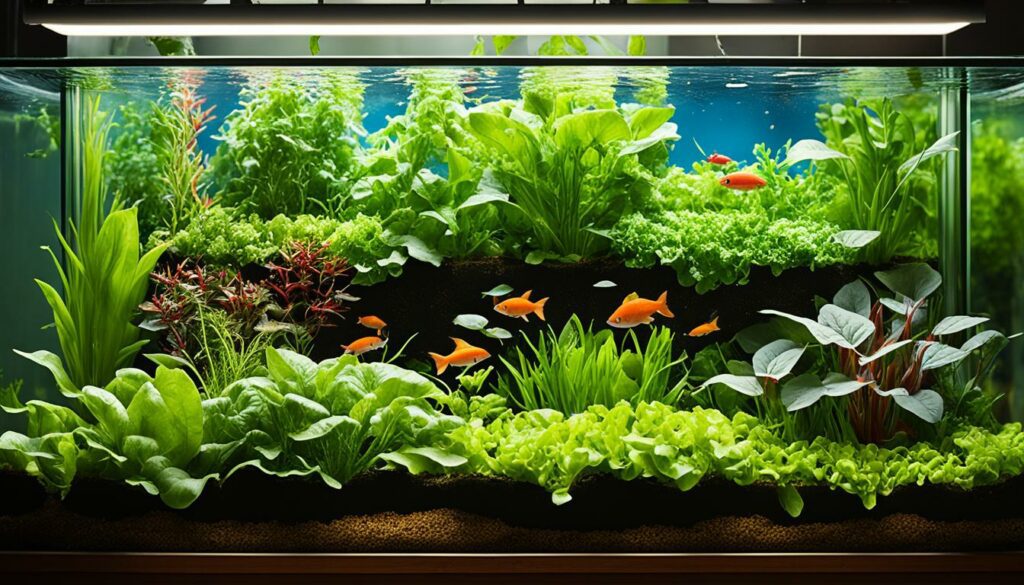
In aquaponics, keeping the water clean is essential. This ensures that both fish and plants thrive. It’s about creating a healthy environment for all.
| Aspect | Benefit |
|---|---|
| Water Usage | Reduces by up to 90% compared to traditional farming |
| Environmental Impact | Minimises the need for synthetic fertilisers and pesticides |
| Space Efficiency | Allows set-up in urban and limited space areas |
| Resource Utilisation | More efficient and promotes renewable energy use |
| Employment Opportunities | Boosts sectors like agriculture, technology, and education |
Aquaponics is great for food security. It offers fresh food all year. It uses renewable energy and cuts down on waste.
It also helps in making the economy stronger. It needs less space and water, making it a smart choice for the future.
The need for sustainable farming is crucial. We must meet growing food needs without harming the environment. I have looked at many green ways to farm, like using technology and growing food naturally.
These new farming methods help us grow more food without hurting the land. They include using advanced technology and growing food indoors. Every new method helps our farms be more sustainable. For example, farms that have trees along with crops help both the land and the forest. In countries like Canada and Indonesia, special efforts are being made to manage forests well.
Working towards better farming involves many people, like scientists and experts from different fields. They study and experiment to find solutions for farming problems. By working together and getting help from places like SARE, we can make farming that doesn’t just help farmers but also our society and the planet.
After exploring these sustainable farming methods, it’s clear that the future of farming is in our hands. Choosing the right ways to farm sustainably is key. This ensures farming stays important for our progress, while also protecting the planet for our children.
Key sustainable farming innovations include precision agriculture, farm automation technologies, and indoor vertical farming. They also involve bee vectoring technology and wastewater treatment. Drones and AI are now integrated in farming too, along with sustainable crop production methods. These innovations help farmers use resources wisely and care for the environment.
Precision agriculture uses high-tech tools like advanced mapping and soil sensors. It analyses data to know exactly what a crop needs. This lets farmers use resources better, save money, and protect the planet, all while growing more food.
Satellite imagery and drones give farmers heat maps and soil information. They help farmers see which areas need more care, saving water and fertiliser. This way, technology improves how we grow food, using resources smarter.
Self-driven tractors and robots for weeding make farming more precise and save farmers time. This cuts down on labour and uses less energy. Farm automation ultimately makes managing a farm easier and more cost-effective.
Indoor vertical farming grows crops without soil, using hydroponics and aeroponics. It saves a lot of water and doesn’t harm the soil. This method makes food production possible in cities year-round, even in small areas with odd weather.
Bee vectoring helps plants by letting bees carry good bacteria during pollination. It cuts down on chemicals, makes plants healthier and more productive. This helps farming be kinder to the earth and the helpful bees we need for pollination.
Wastewater treatment includes closed-loop systems and recycling water on the farm. It cuts the need for new water, helping with the global water shortage. This practice shows that farmers are working to protect the earth’s resources.
Drones and AI watch over crops, spotting problems like pests and diseases early. They let farmers act quickly and precisely to protect their crops. This means healthier crops, less waste, and more efficient farming.
Sustainable farming involves using renewable resources, growing different crops, and saving soil and water. These methods make farming more effective and kinder to the planet. They ensure we have enough food without damaging nature.
Regenerative agriculture focuses on making the soil healthier. It does this by using cover crops and not tilling the soil too much. These steps keep the land alive, making farming possible for a long time in a way that doesn’t harm our world.
Green technology includes things like wind and solar power and natural ways to control pests. These advances make farming less damaging to the environment. They also help farmers produce food in a way that’s good for the earth.
Organic farming cares about wildlife and soil health. It avoids using chemical sprays that harm the environment. By working with nature, it helps keep the land and the food it grows healthy for us all.
Aquaponics combines fish farming with growing plants in water. It’s a smart way to use water and space better. This method allows for continual food growing, which is perfect for areas where there isn’t a lot of farmland.